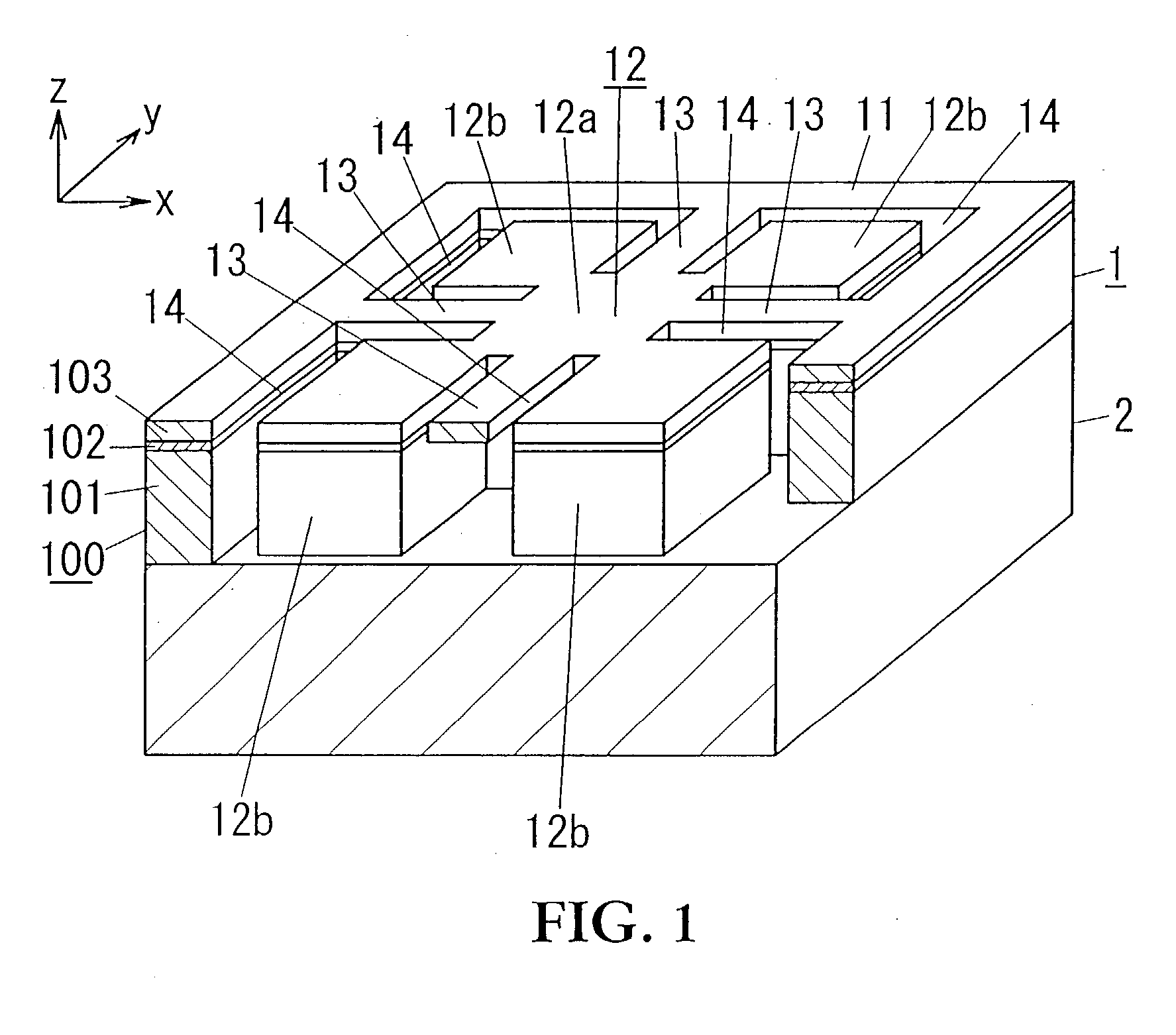Semiconductor acceleration sensor using doped semiconductor layer as wiring
a semiconductor layer and acceleration sensor technology, applied in the direction of acceleration measurement in multiple dimensions, acceleration measurement using interia forces, instruments, etc., can solve the problems of reducing the operational reliability of the acceleration sensor, increasing the fluctuation width of the offset voltage, and deteriorating the detection accuracy of the acceleration sensor
- Summary
- Abstract
- Description
- Claims
- Application Information
AI Technical Summary
Benefits of technology
Problems solved by technology
Method used
Image
Examples
first embodiment
[0037] (First Embodiment)
[0038] In a semiconductor multi-axial acceleration sensor of this embodiment, as shown in FIG. 1, a sensor body 1 is formed by use of a SOI substrate 100 having an embedded oxide layer 102 such as silicon oxide as an intermediate layer, and fixed to a glass cover 2 by anodic bonding. The SOI substrate 100 is composed of a base substrate 101 of silicon, an n-type silicon layer (silicon active layer) 103 having a smaller thickness than the base substrate, and the embedded oxide layer 102 provided therebetween as an insulating layer. It is preferred that a thickness of the base substrate 101 is in a range of 400 to 600 .mu.m, thickness of the embedded oxide film 102 is in a range of 0.3 to 1.5 .mu.m, and the thickness of the silicon layer 103 is in a range of 4 to 6 .mu.m.
[0039] As shown in FIGS. 1 and 3, this sensor body 1 has a rectangular frame 11, a weight 12, and two pairs of beams 13 each having a smaller thickness than the frame. The weight 12 is support...
second embodiment
[0068] (Second Embodiment)
[0069] A semiconductor multi-axial acceleration sensor of this embodiment is substantially the same as that of the first embodiment except for the following features. Therefore, no duplicate explanation is deemed to be necessary.
[0070] The acceleration sensor of this embodiment has a wiring layout different from the first embodiment. That is, as shown in FIG. 9, with respect to pair of beams 13 extending in the X-axis direction, wiring patterns of doped semiconductor layers 15 formed on one of the beams 13 and the wiring patterns of the doped semiconductor layers 15 formed on the other beam 13 are symmetric with respect to a vertical center line extending in the Y-axis direction through a center of width of each of the beams. Similarly, with respect to pair of beams 13 extending in the Y-axis direction, wiring patterns of doped semiconductor layers 15 formed on one of the beams 13 and the wiring patterns of the doped semiconductor layers 15 formed on the ot...
third embodiment
[0072] (Third Embodiment)
[0073] A semiconductor multi-axial acceleration sensor of this embodiment is substantially the same as that of the second embodiment except for the following features. Therefore, no duplicate explanation is deemed to be necessary.
[0074] The acceleration sensor of this embodiment has a wiring layout different from the second embodiment. That is, as shown in FIG. 10, with respect to pair of beams 13 extending in the X-axis direction, wiring patterns of doped semiconductor layers 15 formed on one of the beams 13 and the wiring patterns of the doped semiconductor layers 15 formed on the other beam 13 are rotationally symmetric with respect to a center point of the top surface of the center weight 12a by 180 degrees. Similarly, with respect to pair of beams 13 extending in the Y-axis direction, wiring patterns of doped semiconductor layers 15 formed on one of the beams 13 and the wiring patterns of the doped semiconductor layers 15 formed on the other beam 13 are...
PUM
 Login to View More
Login to View More Abstract
Description
Claims
Application Information
 Login to View More
Login to View More - R&D
- Intellectual Property
- Life Sciences
- Materials
- Tech Scout
- Unparalleled Data Quality
- Higher Quality Content
- 60% Fewer Hallucinations
Browse by: Latest US Patents, China's latest patents, Technical Efficacy Thesaurus, Application Domain, Technology Topic, Popular Technical Reports.
© 2025 PatSnap. All rights reserved.Legal|Privacy policy|Modern Slavery Act Transparency Statement|Sitemap|About US| Contact US: help@patsnap.com



